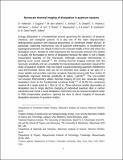| dc.contributor.author | Halbertal, D. | |
| dc.contributor.author | Cuppens, J. | |
| dc.contributor.author | Shalom, M. Ben | |
| dc.contributor.author | Embon, L. | |
| dc.contributor.author | Shadmi, N. | |
| dc.contributor.author | Anahory, Y. | |
| dc.contributor.author | Naren, H. R. | |
| dc.contributor.author | Sarkar, J. | |
| dc.contributor.author | Uri, A. | |
| dc.contributor.author | Ronen, Y. | |
| dc.contributor.author | Myasoedov, Y. | |
| dc.contributor.author | Joselevich, E. | |
| dc.contributor.author | Geim, A. K. | |
| dc.contributor.author | Zeldov, E. | |
| dc.contributor.author | Levitov, Leonid | |
| dc.date.accessioned | 2017-06-16T19:14:31Z | |
| dc.date.available | 2017-06-16T19:14:31Z | |
| dc.date.issued | 2016-10 | |
| dc.date.submitted | 2015-11 | |
| dc.identifier.issn | 0028-0836 | |
| dc.identifier.issn | 1476-4687 | |
| dc.identifier.uri | http://hdl.handle.net/1721.1/109976 | |
| dc.description.abstract | Energy dissipation is a fundamental process governing the dynamics of physical, chemical and biological systems. It is also one of the main characteristics that distinguish quantum from classical phenomena. In particular, in condensed matter physics, scattering mechanisms, loss of quantum information or breakdown of topological protection are deeply rooted in the intricate details of how and where the dissipation occurs. Yet the microscopic behaviour of a system is usually not formulated in terms of dissipation because energy dissipation is not a readily measurable quantity on the micrometre scale. Although nanoscale thermometry has gained much recent interest existing thermal imaging methods are not sensitive enough for the study of quantum systems and are also unsuitable for the low-temperature operation that is required. Here we report a nano-thermometer based on a superconducting quantum interference device with a diameter of less than 50 nanometres that resides at the apex of a sharp pipette: it provides scanning cryogenic thermal sensing that is four orders of magnitude more sensitive than previous devices—below 1 μK Hz[superscript −1/2]. This non-contact, non-invasive thermometry allows thermal imaging of very low intensity, nanoscale energy dissipation down to the fundamental Landauer limit of 40 femtowatts for continuous readout of a single qubit at one gigahertz at 4.2 kelvin. These advances enable the observation of changes in dissipation due to single-electron charging of individual quantum dots in carbon nanotubes. They also reveal a dissipation mechanism attributable to resonant localized states in graphene encapsulated within hexagonal boron nitride, opening the door to direct thermal imaging of nanoscale dissipation processes in quantum matter. | en_US |
| dc.language.iso | en_US | |
| dc.publisher | Nature Publishing Group | en_US |
| dc.relation.isversionof | http://dx.doi.org/10.1038/nature19843 | en_US |
| dc.rights | Creative Commons Attribution-Noncommercial-Share Alike | en_US |
| dc.rights.uri | http://creativecommons.org/licenses/by-nc-sa/4.0/ | en_US |
| dc.source | arXiv | en_US |
| dc.title | Nanoscale thermal imaging of dissipation in quantum systems | en_US |
| dc.type | Article | en_US |
| dc.identifier.citation | Halbertal, D.; Cuppens, J.; Shalom, M. Ben; Embon, L.; Shadmi, N.; Anahory, Y. and Naren, H. R. et al. “Nanoscale Thermal Imaging of Dissipation in Quantum Systems.” Nature 539, no. 7629 (October 2016): 407–410 © 2016 Macmillan Publishers Limited, part of Springer Nature | en_US |
| dc.contributor.department | Massachusetts Institute of Technology. Department of Physics | en_US |
| dc.contributor.mitauthor | Levitov, Leonid | |
| dc.relation.journal | Nature | en_US |
| dc.eprint.version | Author's final manuscript | en_US |
| dc.type.uri | http://purl.org/eprint/type/JournalArticle | en_US |
| eprint.status | http://purl.org/eprint/status/PeerReviewed | en_US |
| dspace.orderedauthors | Halbertal, D.; Cuppens, J.; Shalom, M. Ben; Embon, L.; Shadmi, N.; Anahory, Y.; Naren, H. R.; Sarkar, J.; Uri, A.; Ronen, Y.; Myasoedov, Y.; Levitov, L. S.; Joselevich, E.; Geim, A. K.; Zeldov, E. | en_US |
| dspace.embargo.terms | N | en_US |
| dc.identifier.orcid | https://orcid.org/0000-0002-4268-731X | |
| mit.license | OPEN_ACCESS_POLICY | en_US |
| mit.metadata.status | Complete | |
